Western Digital WD740ADFD: Bottled Lightning
by Gary Key on February 7, 2007 3:30 AM EST- Posted in
- Storage
iPeak Business Application Tests
Our iPeak Winstone benchmarks offer a glimpse into how well our hard disk drives will handle general office applications, media encoding, and graphics manipulation. While the business applications that are being tested tend to be more CPU bound at times, the performance of the hard drive can and will make a difference in the more disk intensive video and graphics applications where large media files are typically being edited.
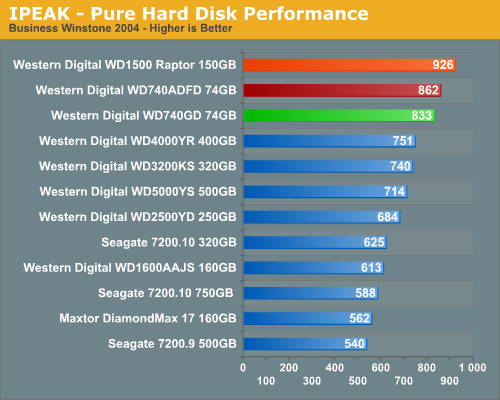
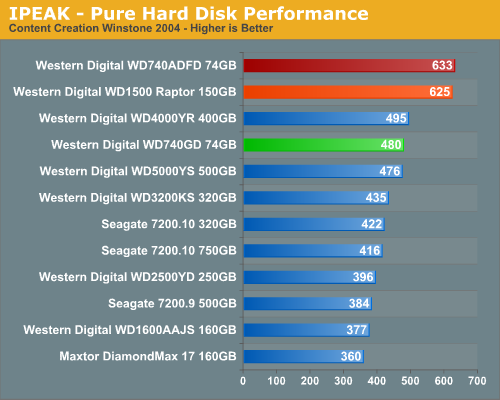
As expected the WD Raptor drives finish at the top in our business application tests as their 10k RPM spindle speed and optimized cache play an important role in their ability to sustain high transfer rates, especially in the Content Creation benchmark where transfer block sizes are significantly larger and more random than in the Business application benchmark. We see our WD74ADFD finishing ahead of the WD1500ADFD in the Content Creation benchmark where write operations account for a large portion of the test and just barely trailing in the Business Winstone test that emphasizes small block sizes of data in non-sequential order.
iPeak General Task Tests
The iPeak based General Task benchmarks are designed to replicate utility based application tasks that typically are disk intensive and represent common programs utilized on the majority of personal computers. While the WinRAR program is very CPU intensive it will typically stress the storage system in short bursts. Our antivirus benchmark will stress the storage system with continual reads and sporadic write requests while the defragmentation process is split between continual read and write requests.
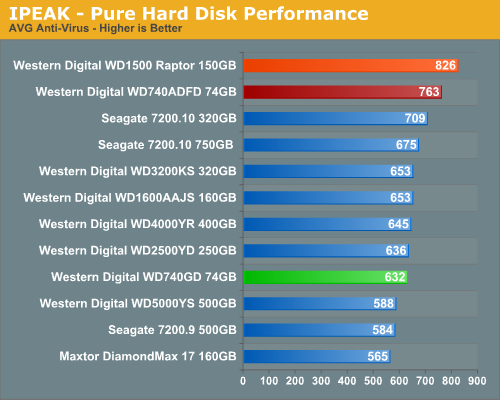
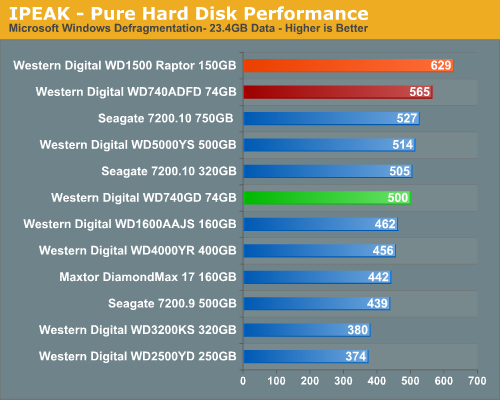
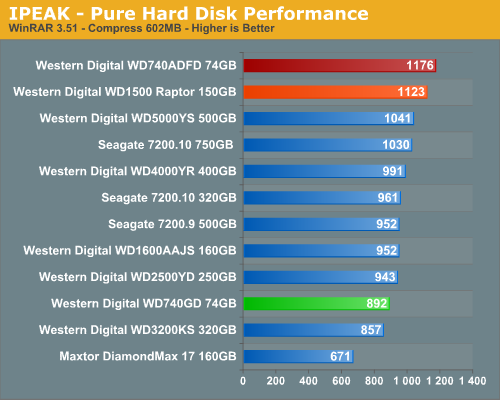
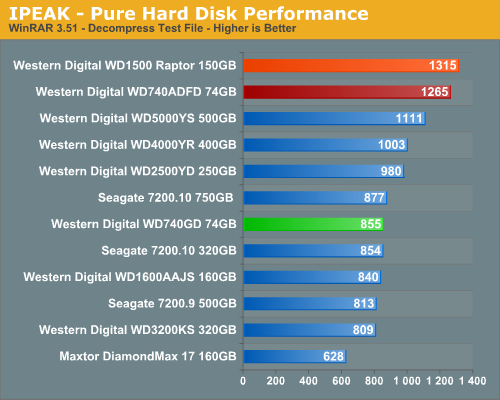
The WD740ADFD slightly trails the WD1500ADFD in our AVG and Defragmentation tests with results that mirror the PCMark 2005 testing. The WD1500ADFD performs better in tests slanted towards read operations while the WD740ADFD performs as well or better in write operations due to slightly better sustained transfer rates. Our WD740GD is unable to keep up with the other Raptor drives - or for that matter several of our other drives that contain the larger 16MB cache sizes. This is especially true in the WinRAR tests where large cache sizes are very advantageous for improved performance.
Our iPeak Winstone benchmarks offer a glimpse into how well our hard disk drives will handle general office applications, media encoding, and graphics manipulation. While the business applications that are being tested tend to be more CPU bound at times, the performance of the hard drive can and will make a difference in the more disk intensive video and graphics applications where large media files are typically being edited.


As expected the WD Raptor drives finish at the top in our business application tests as their 10k RPM spindle speed and optimized cache play an important role in their ability to sustain high transfer rates, especially in the Content Creation benchmark where transfer block sizes are significantly larger and more random than in the Business application benchmark. We see our WD74ADFD finishing ahead of the WD1500ADFD in the Content Creation benchmark where write operations account for a large portion of the test and just barely trailing in the Business Winstone test that emphasizes small block sizes of data in non-sequential order.
iPeak General Task Tests
The iPeak based General Task benchmarks are designed to replicate utility based application tasks that typically are disk intensive and represent common programs utilized on the majority of personal computers. While the WinRAR program is very CPU intensive it will typically stress the storage system in short bursts. Our antivirus benchmark will stress the storage system with continual reads and sporadic write requests while the defragmentation process is split between continual read and write requests.




The WD740ADFD slightly trails the WD1500ADFD in our AVG and Defragmentation tests with results that mirror the PCMark 2005 testing. The WD1500ADFD performs better in tests slanted towards read operations while the WD740ADFD performs as well or better in write operations due to slightly better sustained transfer rates. Our WD740GD is unable to keep up with the other Raptor drives - or for that matter several of our other drives that contain the larger 16MB cache sizes. This is especially true in the WinRAR tests where large cache sizes are very advantageous for improved performance.










26 Comments
View All Comments
AnnonymousCoward - Tuesday, February 13, 2007 - link
Good review. I don't think I'll ever buy one of these. For as expensive as they are, the storage size is small and the performance diff is minuscule. Sims2 loading: 30s vs 31s! MP4 conversion: 3:04 vs 3:14! Amazing!Then the thermals and acoustics are really bad.
Lakeshow - Friday, February 9, 2007 - link
I think 74GB is plenty for an OS drive (hell even 36GB should suffice). Sure a 500 gig is cheaper, but I would never use that as my OS drive: simply too much stuff to back up when doing a reformat. Yeah I can do partitions, but then file transfer between partitions is much slower than between two drives, which is why I have my 74GB Raptor as OS drive, 500 giger as D:/storage drive, and then a 36GB Raptor as E: drive for torrent downloads.JonathanYoung - Thursday, February 8, 2007 - link
I think the graphs look great, but in the ones with minutes and seconds, I would suggest using a colon (e.g. 3:05) to denote minutes:seconds instead of a decimal, which makes me think 3.05 minutes (3 minutes 3 seconds). Thanks.Gary Key - Thursday, February 8, 2007 - link
We have an updated graphing engine coming on-line in the next few weeks that hopefully will fix that issue. It bugs me to no end to use the decimal point in that way. ;)TheBeagle - Wednesday, February 7, 2007 - link
Gary, as usual, you did a helluva job on a first-class review on these new generation Raptor drives. However, you especially captured my attention when you wrote "Although TLER is disabled by default, a utility is available from Western Digital to enable TLER." The existence of such a "utility" was a revelation to me. I have a couple of these same 74 GB and 150GB drives, each running in pairs in a RAID 1 environment, and I didn't have any knowledge of such an enabling/disabling "utility." Can you share the source for such a little delight and how we mere mortals get our hands in such a thing? Thanks again for a stellar report, and now we can just hope that WD adopts perpendicular recording (ala 7200.10) and SATA II specs for a world-beater drive. TheBeagleTheBeagle - Saturday, February 17, 2007 - link
I got WD to send me a copy of the TLER "utility." To my surprise, when you run it on new generation Raptor or "YS" series drives, it shows you some very interesting information. First of all there are two (2) separate TLER setting for these drives, namely a read setting and a write setting. On Raptor drives, BOTH ARE DISABLED from the factory! That's right, even though WD advertises this feature as being built into the Raptor drives, it's NOT OPERATIONAL unless you get your hands on the "secret" utility and activate it. On the YS drives, ONLY THE READ feature is activated, and the write feature is disabled. BTW, although WD says that the TLER feature on YS series drives cannot be disabled, the utility has a command that will do just that, disable both the read and write (if you have activated it) feature on those drives. I think WD has some serious explaining to do about all of this, since they (WD) have been creating a false impression to the buying public about these TLER features in these drives!Makaveli - Wednesday, February 7, 2007 - link
he is right it all comes down to your usages pattern, in general home users don't need Raid O. However, if u happen to say be running a webserver from home, or doing alot of Disk intensive stuff its a good investment, but the original Comment still stands.I would never go raid 0 in a gaming rig, a 75/150 Raptor + Storage drive is a far more optimal solution.
Makaveli - Wednesday, February 7, 2007 - link
hey is right it all comes down to your usages pattern, in general home users don't need Raid O. However, if u happen to say be running a webserver from home, or doing alot of Disk intensive stuff its a good investment, but the original Comment still stands.I would never go raid 0 in a gaming rig, a 75/150 Raptor + Storage drive is a far more optimal solution.
Brassbullet - Wednesday, February 7, 2007 - link
So does the fact that I have a WD740ADFD-00NLR as my Windows XP boot drive and a Seagate 7200.10 750 GB as my "My Documents" location mean I'm living the I/O dream? I've had this setup for months and didn't really think much of it, man was this article a PC ego booster!!littlebitstrouds - Wednesday, February 7, 2007 - link
This makes me feel good about the $109 I just paid for my new 150gig at BB because I Vista too.